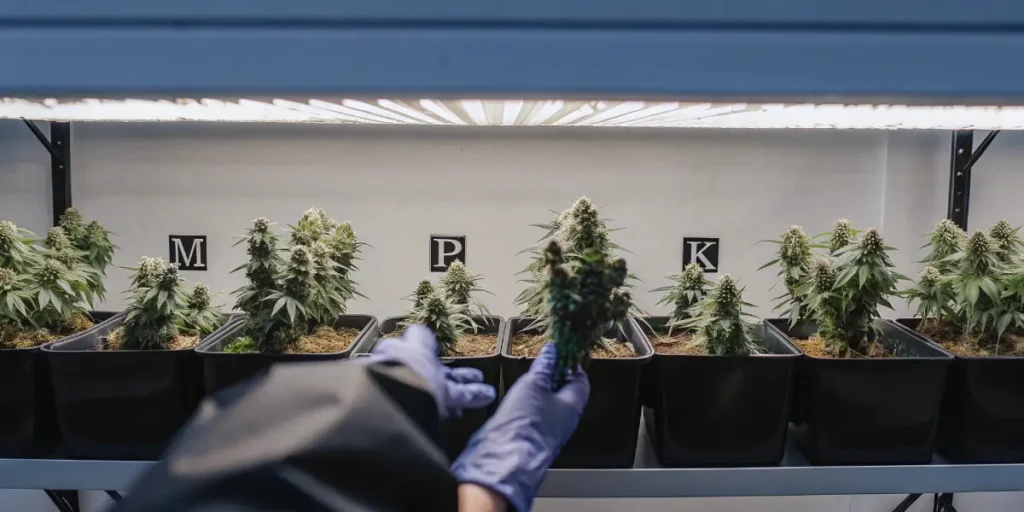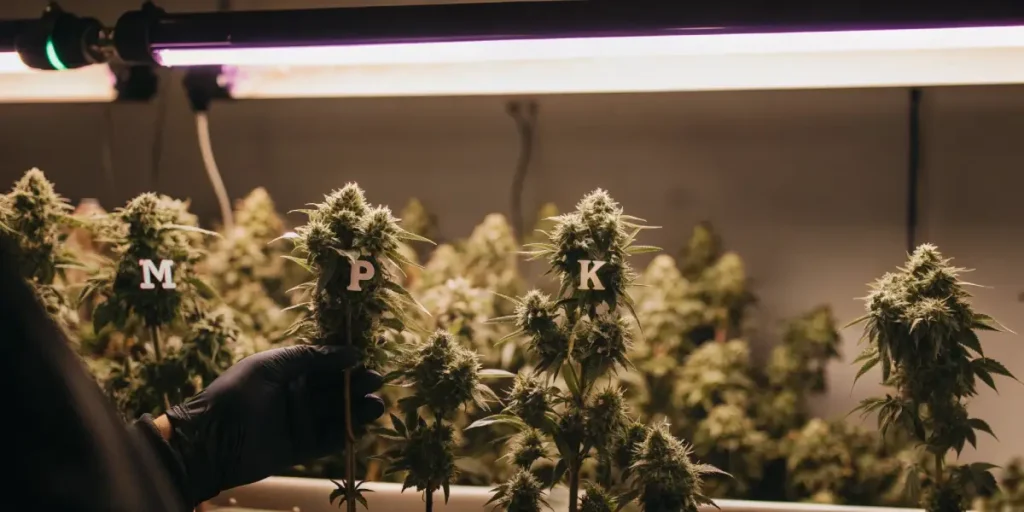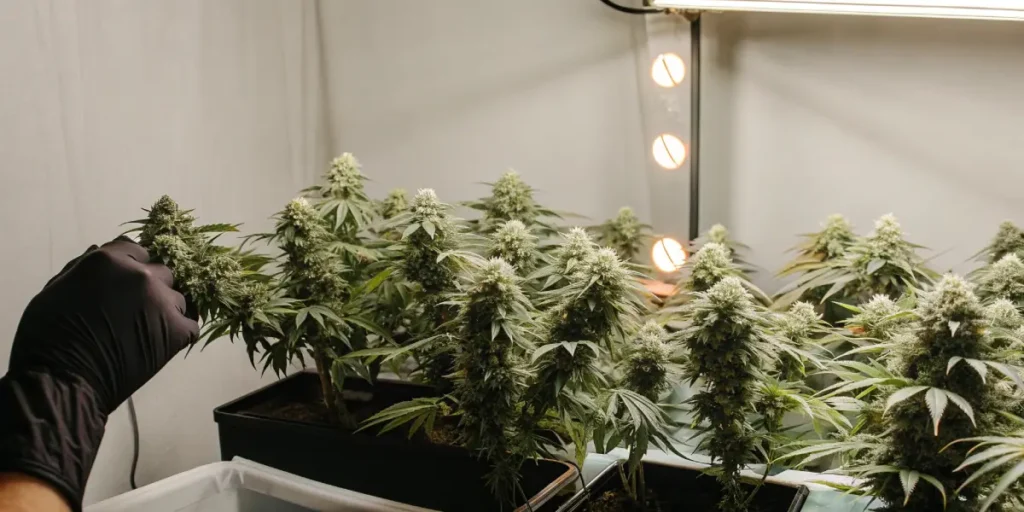
Top Nutrient Solutions for Autoflowers: A Grower’s Guide
Cultivating autoflower cannabis strains requires the right balance of care, technique, and nutrients to ensure they thrive. For growers looking to maximize their yields and potency, understanding the best autoflower nutrients is crucial. In this guide, we’ll explore everything you need to know to nourish your plants effectively.
Why Nutrients Are Essential for Autoflowers
Autoflower Nutritional Needs
Autoflowers, unlike photoperiod plants, follow a fixed growth cycle, typically completing their life span in 8-12 weeks. This accelerated growth means they require a consistent supply of essential nutrients from the start. The right balance of macronutrients, nitrogen (N), phosphorus (P), and potassium (K), is vital for supporting their vegetative and flowering stages.
Recommended Strains
Apple Fritter
|
|
THC | 22% - 25% (Medium) |
|
|
Type | Feminized |
|
|
Yield | Medium |
|
|
Phenotype | 60% Indica / 40% Sativa |
Apple Fritter Autoflower
|
|
THC | 22% - 25% (Medium) |
|
|
Type | Autoflowering |
|
|
Yield | Medium |
|
|
Phenotype | 60% Indica / 40% Sativa |
Without proper nutrients, autoflowers may develop deficiencies, leading to stunted growth, poor bud development, and reduced yields. Choosing the best autoflower nutrients ensures your plants stay healthy throughout their life cycle. Additionally, a robust nutrient regimen supports the plant’s natural resistance to pests and diseases, contributing to an overall successful harvest.
Differences Between Autoflower and Photoperiod Nutrient Requirements
Autoflowers generally require less nitrogen than photoperiod plants due to their smaller size and faster growth. They also have a shorter vegetative stage, meaning their nutrient needs transition quickly to phosphorus and potassium during flowering. Overfeeding can stress these plants, making precise nutrient application even more critical. These differences emphasize the importance of tailored nutrient solutions designed specifically for autoflowers, ensuring they receive the support needed for each unique growth phase.
Promos & Deals
Key Nutrients for Autoflower Growth
Nitrogen for Vegetative Growth
During the early stages, nitrogen is essential for leaf and stem development. It supports chlorophyll production, ensuring your plants have the energy to grow robust structures. Use a nitrogen-rich fertilizer during the vegetative phase to promote healthy growth. Proper nitrogen levels also aid in photosynthesis, enabling your plants to develop quickly and prepare for the demanding flowering stage.
Nitrogen deficiencies often manifest as yellowing leaves and stunted growth. By maintaining consistent nitrogen levels, you can encourage vigorous plant development, ensuring they reach their full potential before transitioning to flowering.
Phosphorus and Potassium for Flowering
As autoflowers enter the flowering stage, their focus shifts from structural growth to bud development. Phosphorus boosts flower formation and root health, while potassium enhances bud density and resilience. Transitioning to a nutrient formula with higher phosphorus and potassium levels is key during this stage. These nutrients also contribute to the plant’s ability to withstand environmental stress, ensuring your harvest is plentiful and high-quality.
Potassium also helps improve the plant’s overall resistance to disease and pests. Ensuring a balance of these key nutrients during flowering ensures your autoflowers produce dense, resinous buds with superior potency and flavor.
The Importance of Micronutrients
Micronutrients like calcium, magnesium, and sulfur play supporting roles in autoflower health. Calcium strengthens cell walls, magnesium aids in photosynthesis, and sulfur contributes to protein synthesis. Including these elements in your nutrient regimen ensures balanced growth. Ensuring these micronutrients are consistently available prevents common issues such as leaf discoloration and reduced plant vigor, resulting in healthier, more vibrant crops.
Micronutrients also enhance the plant’s ability to absorb macronutrients, improving overall growth efficiency. By addressing these critical needs, you can optimize plant health and maximize yields.

Types of Nutrients for Autoflowers
Organic Nutrients: A Natural Approach
Organic nutrients, derived from natural sources, improve soil health and promote sustainable growing practices. They release nutrients slowly, ensuring a steady supply for your plants. Popular organic options include compost teas, worm castings, and bat guano. These options not only enhance plant growth but also contribute to the overall health of the growing medium, fostering a thriving ecosystem for your autoflowers.
Using organic nutrients also minimizes the risk of overfeeding and nutrient burn, making them an excellent choice for beginner growers. They encourage the development of beneficial microbes in the soil, further boosting plant health and yield potential.
Synthetic Nutrients for Precise Feeding
Synthetic nutrients offer precise control over nutrient ratios, allowing growers to tailor feeding schedules to their plants’ needs. These nutrients are available in pre-mixed formulas and are ideal for hydroponic systems where accuracy is crucial. By providing immediate availability of nutrients, synthetic solutions are perfect for growers aiming to maximize growth rates and yields within tight timelines.
Many synthetic options are also designed for easy absorption, ensuring plants receive the nutrients they need exactly when they need them. This precision helps reduce waste and improve overall growing efficiency.
Liquid vs. Granular Nutrients
Liquid nutrients are easy to mix and apply, making them suitable for beginners. Granular nutrients, on the other hand, provide a slow-release option, reducing the frequency of applications. Both types have their advantages depending on your growing setup. Liquid options are often favored for hydroponics and drip systems, while granular nutrients excel in outdoor or soil-based grows. Granular nutrients are also ideal for long-term feeding schedules, as they gradually release nutrients over time. This makes them a convenient choice for growers who prefer low-maintenance feeding routines.
Best Autoflower Nutrient Products in 2024
High-Performance Nutrients for Vigorous Growth
For growers seeking maximum yields, high-performance nutrient brands offer specialized formulas designed to boost growth and flowering. Look for products rich in phosphorus and potassium to enhance bud production. High-performance formulas often include additional micronutrients and bio-stimulants, creating a comprehensive feeding solution for your autoflowers.
These products are specifically engineered to support rapid growth cycles, ensuring your autoflowers achieve their full potential within their short life span. They’re perfect for growers aiming to achieve professional-grade results.
Balanced Fertilizers for All Stages
Some products provide balanced NPK ratios suitable for the entire growth cycle, simplifying nutrient management. These are excellent for beginner growers who want a straightforward feeding schedule. Balanced fertilizers reduce the risk of overfeeding or nutrient lockout, making them a reliable choice for consistent results.
Balanced options are also versatile, allowing growers to adapt their feeding practices to suit different strains and environmental conditions. They’re an all-in-one solution for maintaining plant health from seedling to harvest.
Budget-Friendly Options for Autoflower Cultivation
Growing cannabis doesn’t have to break the bank. Budget-friendly nutrient options deliver quality results without compromising on plant health. Many affordable products still include essential macronutrients and micronutrients. These cost-effective solutions are ideal for small-scale growers or those experimenting with different cultivation techniques.
Affordable nutrient solutions often come in bulk packaging, making them an economical choice for growers managing multiple plants. They’re a practical way to ensure your autoflowers receive the care they need without exceeding your budget.
How to Use Nutrients Effectively for Autoflowers
Nutrient Schedules for Each Growth Stage
Start with a nitrogen-rich formula during the vegetative stage. As plants transition to flowering, switch to a bloom booster with higher phosphorus and potassium. Adjust feeding frequency based on your plants’ growth and environmental conditions. Adhering to a well-structured schedule ensures that your plants receive the nutrients they need when they need them most.
Mixing and Measuring Nutrients Correctly
Always follow the manufacturer’s instructions for mixing nutrients. Use a reliable EC (electrical conductivity) meter to measure nutrient concentration, ensuring it’s within the recommended range for autoflowers. Precise mixing not only prevents nutrient burn but also ensures optimal nutrient availability throughout your plant’s life cycle.
Avoiding Overfeeding and Nutrient Burn
Overfeeding can damage your plants, causing yellowing leaves and stunted growth. Start with a lower nutrient concentration and gradually increase it as your plants show signs of healthy growth. Regularly flush your medium to prevent salt buildup. These practices maintain a balanced nutrient environment, promoting vigorous, healthy growth.
Tips for Maximizing Autoflower Yields with Nutrients
Adjusting Nutrients Based on Plant Signals
Observing your plants closely is crucial for maximizing autoflower yields. Watch for signs such as leaf discoloration, wilting, or unusual growth patterns, which can indicate deficiencies or excesses in nutrients. For instance, yellowing leaves may suggest a nitrogen deficiency, while burnt leaf tips often signal nutrient burn. By fine-tuning your nutrient schedule based on these signals, you can ensure optimal growth and health throughout the plant’s life cycle.
Consistently monitoring your plants allows for timely adjustments. For example, during the flowering stage, you might need to increase phosphorus and potassium while reducing nitrogen. This targeted approach ensures that your autoflowers are always receiving the specific nutrients they need for each growth phase, enhancing overall yields and quality.
Pairing Nutrients with Proper Watering Techniques
Watering plays a pivotal role in nutrient uptake. Overwatering can lead to nutrient runoff, depriving your plants of essential elements, while underwatering can hinder nutrient absorption. Striking the right balance is key. Aim for a watering schedule that keeps the medium moist but not waterlogged, ensuring roots have access to both water and oxygen.
Incorporate nutrients into your watering routine by diluting them according to the manufacturer’s guidelines. Always test the pH of your nutrient solution, keeping it within the ideal range for autoflowers, typically between 6.0 and 6.5 for soil.
Managing Soil pH for Optimal Nutrient Absorption
Soil pH directly affects the availability of nutrients to your plants. If the pH is too high or too low, certain nutrients may become locked out, preventing your autoflowers from accessing them. Regularly test the pH of your soil and adjust it as needed using pH up or pH down solutions to maintain an optimal range.
Maintaining the correct pH also reduces the risk of nutrient imbalances that can lead to deficiencies or toxicities. Pairing this practice with high-quality nutrients ensures that your autoflowers receive a steady and efficient supply of all essential elements, leading to healthier plants and more robust yields.
Common Mistakes When Using Autoflower Nutrients

Overloading Nutrients During Early Growth
One of the most common mistakes growers make is overfeeding during the seedling and early vegetative stages. Autoflowering nutrients should be applied carefully because autoflowers are naturally smaller and more delicate than photoperiod plants, making them more sensitive to nutrient levels. Excessive feeding can lead to nutrient burn, stunting growth, and reducing overall yields.
Ignoring Micronutrient Deficiencies
While macronutrients like nitrogen, phosphorus, and potassium are vital, neglecting micronutrients can negatively impact your plants. Deficiencies in elements like calcium, magnesium, or iron can cause issues such as weak stems, yellowing leaves, or poor bud development.
Incorporate a balanced nutrient formula that includes both macro and micronutrients to address this. Pay attention to signs of deficiencies and supplement with specific nutrients if needed. Regularly monitoring your plants’ health ensures that no nutrient requirement goes unmet, leading to stronger and more productive autoflowers.
Using Incompatible Nutrient Products
Mixing incompatible nutrient products can create chemical reactions that render some nutrients unavailable to plants. For example, combining certain calcium and phosphorus products can cause precipitation, forming insoluble compounds that your plants cannot absorb.
Always check product labels and compatibility charts when using multiple nutrients. If unsure, use premixed nutrient solutions designed for autoflowers to avoid conflicts. This practice ensures that all nutrients remain available for uptake, supporting optimal plant health and growth.
FAQs About the Best Autoflower Nutrients
What Are the Best Nutrients for Autoflowers in Soil?
The best nutrients for autoflowers in soil include organic options like compost teas, worm castings, and bat guano, which enrich the soil naturally. These provide a steady release of essential macronutrients and micronutrients, supporting healthy growth. For synthetic options, look for balanced NPK formulas specifically designed for autoflowers, ensuring they meet the plants’ unique needs.
Can Autoflowers Thrive Without Additional Nutrients?
While autoflowers can survive without additional nutrients in nutrient-rich soil, their growth and yield may be limited. Supplemental feeding during the vegetative and flowering stages ensures that the plants reach their full potential. Using high-quality nutrients tailored for autoflowers can significantly enhance bud density, flavor, and overall yield.
How Often Should I Feed Nutrients to Autoflowers?
Nutrient feeding frequency depends on the growth stage and the medium used. For soil grows, feeding once every 7-10 days during the vegetative stage and more frequently during flowering is common. Always monitor your plants and adjust based on their response. Avoid overfeeding to prevent nutrient burn and ensure steady, healthy growth.



















